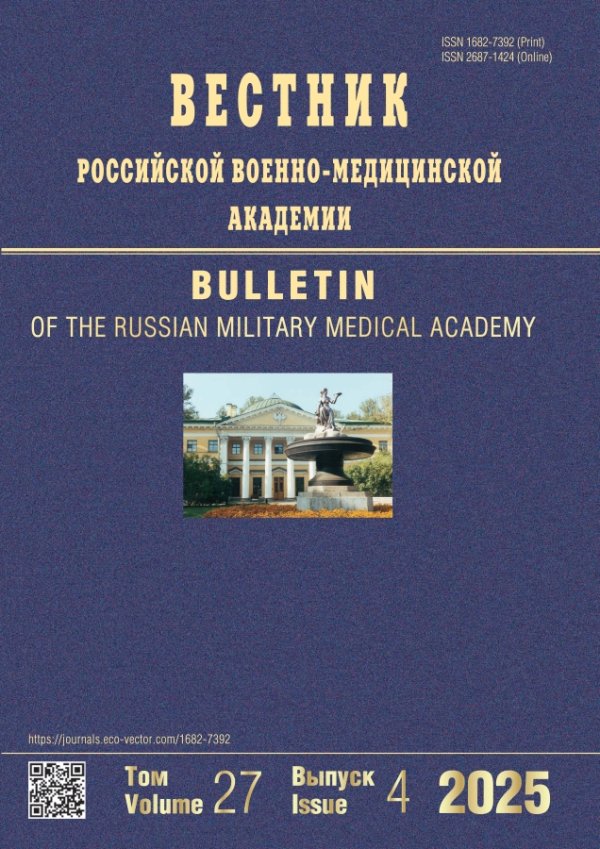ОСОБЕННОСТИ МОРФОФУНКЦИОНАЛЬНЫХ ПОКАЗАТЕЛЕЙ СЕРДЕЧНО-СОСУДИСТОЙ СИСТЕМЫ У МУЖЧИН МОЛОДОГО ВОЗРАСТА С ПРИЗНАКАМИ ДИСПЛАЗИИ СОЕДИНИТЕЛЬНОЙ ТКАНИ
- Авторы: Ефимов С.В.1, Черкашин Д.В.1, Андрианов В.П.1, Аланичев А.Е.1, Кутелев Г.Г.1, Лидерман А.А.1
-
Учреждения:
- ФГБВОУ ВО «Военно-медицинская академия имени С. М. Кирова» МО РФ
- Выпуск: Том 19, № 1 (2017)
- Страницы: 25-31
- Раздел: Статьи
- URL: https://journals.rcsi.science/1682-7392/article/view/12161
- DOI: https://doi.org/10.17816/brmma12161
- ID: 12161
Цитировать
Полный текст
Аннотация
Полный текст
Открыть статью на сайте журналаОб авторах
Семен Валерьевич Ефимов
ФГБВОУ ВО «Военно-медицинская академия имени С. М. Кирова» МО РФ
Дмитрий Викторович Черкашин
ФГБВОУ ВО «Военно-медицинская академия имени С. М. Кирова» МО РФ
Виктор Павлович Андрианов
ФГБВОУ ВО «Военно-медицинская академия имени С. М. Кирова» МО РФ
Андрей Евгеньевич Аланичев
ФГБВОУ ВО «Военно-медицинская академия имени С. М. Кирова» МО РФ
Геннадий Геннадьевич Кутелев
ФГБВОУ ВО «Военно-медицинская академия имени С. М. Кирова» МО РФ
Александр Александрович Лидерман
ФГБВОУ ВО «Военно-медицинская академия имени С. М. Кирова» МО РФ
Список литературы
- Алексеев А. А. Интегративная (системная, семейная) соединительнотканная медицина. М.: Ленанд; 2005. 517.
- Клеменов А. В. Клиническое значение недифференцированной дисплазии соединительной ткани. Дис. … докт. мед. наук. М.; 2005. 238.
- Земцовский Э. В. Соединительнотканные дисплазии сердца. СПб.: Политекс; 2000. 115.
- Кадурина Т. И., Корженевская М. А., Михеев В. С. Генетический анализ в семьях с генерализованной дисплазией соединительной ткани, включающей MASS-фенотип. Артериальная гипертензия. 1999; 5 (1): 26-7.
- Rabkin E. Activated interstitial myofibroblasts express catabolic enzymes and mediate matrix remodeling in myxomatous heart valves. Circulation. 2001; 104 (21): 2525-32.
- Milewicz D. M., Urban Z., Boyd C. Genetic disorders of the elastic fiber system. Matrix Biology. 2000; 19 (6): 471-80.
- Biery N. J., Eldadah Z. A., Moore C. S., Stetten G., Spencer F., Dietz H. C. Revised genomic organization of FBN1 and significance for regulated gene expression. Genomics. 1999; 56 (1): 70-7.
- Henney A. M., Tsipouras P., Schwartz R. C., Child A. H., Devereux R. B., Leech G. J. Genetic evidence that mutations in the COL1A1, COL1A2, COL3A1, or COL5A2 collagen genes are not responsible for mitral valve prolapse. Br. Heart. J. 1989; 61 (3): 292-9.
- Нечаева Г. И. Перспективы реализации здоровьесберегающих технологий в группе пациентов с дисплазиями соединительной ткани. Кубанский научный медицинский вестник. 2009; 6 (111): 64-4.
- Salomon J., Shah P. M., Heinle R. A. Thoracic skeletal abnormalities in mitral valve prolapse. Am. J. Cardiol. 1975; 36 (1): 32-6.
- Bon Tempo C. P., Ronan J. A., de Leon A. C., Twigg H. L. Radiographic appearance of the thorax in systolic-click late systolic murmur syndrome. Am. J. Cardiol. 1975; 36 (1): 27-31.
- Гордон И. Б., Рассохин В. М., Никитина Т. Н. Конституционные (генетически обусловленные) вегетативная дистония и соединительнотканная дисплазия при «идиопатическом» пролапсе митрального клапана. Кардиология. 1984; 1: 63-7.
- Тихонова О. В., Нечаева Г. И., Друк И. В. Вегетативная дисфункция при дисплазии соединительной ткани в практике семейного врача. В сб.: Проблемы и перспективы развития семейной медицины в Сибирском федеральном округе: материалы межрегион. науч.-практ. конф. Омск; 2004: 124-9.
- Национальные рекомендации Российского научного медицинского общества терапевтов по диагностике, лечению и реабилитации пациентов с дисплазиями соединительной ткани. Медицинский вестник Северного Кавказа, 2016; 11 (1): 76.
- Свистунов А. А., Царев О. А., Маслякова Г. Н., Мащенко Ю. В. Клиническое течение варикозной болезни у больных с различной степенью выраженности дисплазии соединительной ткани. Саратовский научно-медицинский журнал. 2009; 5 (2): 261-5.
- Лысенко Л. М., Кузнецова О. А., Шилина Л. В. Патологические изменения сердечно-сосудистой системы у спортсменов на фоне синдрома физического перенапряжения. РМЖ. 2015; 4: 239-4.
- Наследственные нарушения соединительной ткани. Российские рекомендации. Всероссийское научное общество кардиологов. Российский кардиологический журнал. 2012; 4 (96): 32.
Дополнительные файлы







